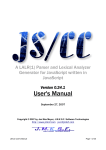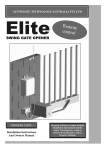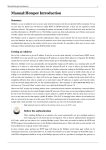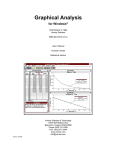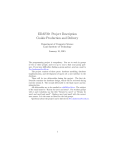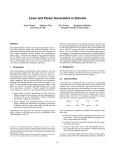Download Here - Js/cc
Transcript
A LALR(1) Parser and Lexical
Analyzer Generator for JavaScript,
written in JavaScript
Version 0.30
User's Manual
Release date
November 20, 2008
Copyright © 2007, 2008 by
Jan Max Meyer, J.M.K S.F. Software Technologies
44265 Dortmund / Germany
http://www.jmksf.com
JS/CC User's Manual
jscc<at>jmksf<dot>com
Page 1 of 34
Table of Contents
1.Introducing JS/CC...............................................................................................................3
Welcome to JS/CC!.....................................................................................................................................3
The intention behind JS/CC.........................................................................................................................4
Changes on this documentation..................................................................................................................4
Future plans.................................................................................................................................................4
Some words by the author...........................................................................................................................5
2.A quick start example..........................................................................................................6
Building JS/CC.............................................................................................................................................6
Installation and Start-Up..............................................................................................................................7
An example parser.......................................................................................................................................9
Compiling the example..............................................................................................................................11
3.The Grammar Definition Language..................................................................................12
General......................................................................................................................................................12
The Terminal Declaration Part...................................................................................................................12
Regular Expressions..................................................................................................................................12
Ambiguous Regular Expressions..........................................................................................................13
Associativity and Precedence...............................................................................................................14
Whitespace...........................................................................................................................................14
The Grammar Definition Part.....................................................................................................................15
Accessing right-hand side items in semantic action..............................................................................15
Value types...........................................................................................................................................16
Resolving conflicts................................................................................................................................16
4.Implementing a scripting language...................................................................................18
The idea.....................................................................................................................................................18
Defining the grammar................................................................................................................................19
Executing the script...................................................................................................................................21
The entire source.......................................................................................................................................21
5.Debugging parsers............................................................................................................29
General......................................................................................................................................................29
Debug facilities..........................................................................................................................................30
Debugging with the Web Environment.......................................................................................................31
License Agreements............................................................................................................32
Credits..................................................................................................................................................34
JS/CC User's Manual
Page 2 of 34
1.Introducing JS/CC
Welcome to JS/CC!
JS/CC is the first available parser development system for JavaScript and ECMAScript-derivatives.
It has been developed, both, with the intention of building a productive compiler development
system and with the intention of creating an easy-to-use academic environment for people
interested in how parse table generation is done general in bottom-up parsing.
JS/CC is a platform-independent software that unions both: A regular expression-based lexical
analyzer generator matching individual tokens from the input character stream and a LALR(1)
parser generator, computing the parse tables for a given context-free grammar specification to
build a stand-alone, working parser. The context-free grammar fed to JS/CC is defined in a
Backus-Naur-Form-based meta language, and allows the insertion of individual semantic code to
be evaluated on a rule's reduction. JS/CC itself has been entirely written in JavaScript so it can be
executed in many different ways:
•
as platform-independent, browser-based JavaScript embedded on a Website, which comes
with a graphical parse tree generator
•
as a Windows Script Host Application or a compiled JScript.NET executable
•
as a Mozilla/Rhino or Mozilla/Spidermonkey interpreted application
•
or as a V8 shell script
All versions can be build and run under Linux, Windows, Mac OSX and any other, *nix-based
operating system. For productive execution, it is recommended to use the command-line versions,
which are capable of assembling a complete compiler from a JS/CC parser specification, which is
then stored to a .js JavaScript source file.
To use JS/CC and for understanding its internals and behavior, some knowledge of context-free
grammars, bottom-up parsing techniques and compiler construction theory, in general, is
assumed. To get a fundamental introduction to compiler design and the different techniques and
appendages on this topic, I warmly suggest to the book Compiler Design in C, written by Allen I.
Holub1.
Maybe in future, the JS/CC user's manual itself (or I'll write a system-independent one) will provide
a detailed introduction on the very huge topic of compiler construction, but for now, I limit this
manual only on the usage of JS/CC itself, and its internals.
Enjoy!
1 Allen I. Holub, Compiler Design in C [Prentice-Hall Software Series], ISBN 978-0131550452
JS/CC User's Manual
Page 3 of 34
The intention behind JS/CC
JS/CC is an open source project released under the terms and conditions of the Artistic License.
When coding JS/CC started in 2007, it was just planned as a quick-and-dirty fun project of
implementing a LALR(1) parser generator in JavaScript for educational purposes, but it rapidly
grew up because tons of more, useful features where added trough the time, that are making it a
productive and usable system for parser construction and for educational issues. The most
amazing thing featured by this software is, that JS/CC is capable to build a complete, working
compiler for any context-free language from a grammar specification with embedded, semantic
code segments within a standard web-browser like Mozilla Firefox.
Since the first public release v0.24 of JS/CC, many things have changed in this project. It received
recommendations and accolades, people started to use it for production and academic issues, and
some fixed bugs and ported it to other platforms.
First focused on Windows with JScript as default platform for the console version of JS/CC, the
project's maintenance system changed over to Linux. Windows will still be supported, but core
development is done on Linux now and in future.
Changes on this documentation
For those who already read the last version of this manual delivered with JS/CC v0.26, you will see
that much changes where made (and the documentation contains lesser pages than the previous
one).
Many mistakes had been corrected, and the complete chapter 6, “Internal documentation” has
been removed. The decision for removing this section is, that JS/CC's file structure has been
completely changed, and much more platforms came in. Most of the internal documentation was
only on describing the several source files of the package, but this information is even hold in the
source files itself. So instead of revising this chapter, it is now simply removed, and the information
necessary for hacking and building JS/CC remains only in the sources.
Future plans
Development on JS/CC still moves on, and the more people using it, the more fun there is of
developing it further. Both the academic and productive ideas behind JS/CC will be followed.
For future releases, a more yacc-styled behavior is planned, plus some features taken from
several other, popular parser generator projects. This includes virtual productions, embedded
semantics, better analysis of the parse table generation process and much more.
An alternative JS/CC front-end with a lex/yacc-like syntax would complete the whole system. It
would be even possible to make JS/CC a parser generator for other target platforms than
ECMAScript – but these are just ideas for now!
JS/CC User's Manual
Page 4 of 34
Some words by the author
The kernel of JS/CC is entirely written and maintained by me, Jan Max Meyer. I'm a software
developer and hobbyist programmer from Germany and was born in 1985. The art of compiler
design is a study on my own, because it very much interests me and makes a lot of fun. This
project is one result of this study. I never studied on computer sciences yet, but plan this
somewhere in the future.
In my professional life, I work as application software developer at a local business software
company. As one of my hobbies, I also run my own, tiny software company – this is J.M.K S.F.
Software Technologies - from home, where I'm in writing programs and solutions around the area
of software development tools, application software and some web-solutions. JS/CC is a non-profit
based product of this business.
There is also another project in the area of computer-aided recognizer generation where I'm
currently on, but more about this will be found out when its finished – and if I really release it.
Now, I wish you much fun and success on using JS/CC. I hope that this software will be useful in
your business or just helps you on understanding how bottom-up parsing works a little more
clearly.
I would deeply appreciate if you have the fun and engagement on developing JS/CC further. Share
it with others, make it popular, or hack its code. That's the way it is meant to be!
So long,
Jan
PS: If you really like JS/CC and if you want to give me a smart pleasure for my efforts in
developing this software, I would be very happy if you maybe take a huger or lesser donation to the
WDCS – Whale and Dolphin Conservation Society – an organization that fights against the
senseless killing and capturing of marine animals, like whales and dolphins, which is unfortunately
the case in some countries of the world today. We must keep this world for us and our children,
and stop this senseless killing of endangered animals. In my opinion, every second counts!
To support the life of whales and dolphins in our oceans, please visit http://www.wdcs.org.
Thank you very much.
JS/CC User's Manual
Page 5 of 34
2.A quick start example
Building JS/CC
JS/CC is a platform independent software. Because of that, you have to set it up for one platform.
By default, JS/CC is targeted to Mozilla/Rhino when downloading the Tarball and to Jscript, both
Windows Script Host and .NET, when downloading the Windows setup.
Under Linux or your *nix-based system, it is recommended to use GNU Make for all buildoperations, under Windows, Microsoft nmake is assumed.
Currently, JS/CC can be build for the following platforms, and builds even parsers for those.
•
Mozilla/Rhino
•
Mozilla/Spidermonkey
•
JScript (Windows Script Host)
•
JScript.NET
•
V8
•
Web environment (HTML/JavaScript, entirely platform-independent)
The Makefile for each supported platform can be found in the src-directory, and follows the
naming-convention Makefile.<platform>. To get additional help and how-to on the various
platforms and how to build JS/CC there, look into the Makefile header comments.
The only Makefile optimized for Windows/nmake is Makefile.jscript, all the rest uses GNU make
under a *nix environment.
JS/CC User's Manual
Page 6 of 34
Installation and Start-Up
To install JS/CC, download the Tarball or Windows setup program. By unpacking/installing it, you
get a pre-configured JS/CC environment which uses Mozilla/Rhino (Tarball), or Microsoft JScript
(setup). The web-environment can be used from both editions and any operating system.
To build JS/CC for other platforms, read the build-howtos in the according Makefiles.
After you successfully built JS/CC, run it with your desired platform. Under windows, you can
simply run jscc.exe or cscript //Nologo jscc.js.
Screenshot 1: Building and invoking JS/CC from a shell
To run JS/CC with Rhino, do rhino jscc.js, and smjs jscc.js for the Spidermonkey version (or
simply ./jscc.js, when execute permission is set). v8sh jscc.js will run the V8 engine as platform.
JS/CC User's Manual
Page 7 of 34
To complete the list of invoking commands, run webenv/jscc.html with your favorite, JavaScriptenabled browser for the web environment ;).
Screenshot 2: The browser-based JS/CC web-environment
JS/CC User's Manual
Page 8 of 34
An example parser
In parser generators like yacc, a simple parser for mathematical expressions is the most widely
used example to become familiar with the syntax and usage, so we do this even here. The parser
definition language itself is described below in a more detailed way.
Store the following grammar definition into a text file of your choice; For parser source files,
the .PAR file extension could be used, so the file is named "calc.par" in such case.
This grammar will go with the platforms Rhino, Spidermonkey and V8. To get it to work with
JScript, all input/output operations need to be replaced by their particular WScript calls. In Web
Environment, use JavaScript's common prompt() and alert() methods.
/~
Expression calculator written in JS/CC
~/
/~
Tokens to be ignored (e.g. whitespace, comments)
~/
!
' |\t'
;
/~
Grammar tokens
~/
'\+'
'\-'
'\*'
'/'
'\('
'\)'
'[0-9]+'
INT
[* %match = parseInt( %match );
*]
'[0-9]+\.[0-9]*|[0-9]*\.[0-9]+'
FLOAT
[* %match = parseFloat( %match );
*]
;
##
/~
The non-terminal "p" is the entry symbol, because it is the first one!
program:
expr
[* print( %1 );
~/
*]
;
/~
Don't confuse with the tokens: Here, we use the unescaped values because these
are not interpretered as regular expressions at this position!
expr:
expr '+' term
[* %% = %1 + %3; *]
| expr '-' term
[* %% = %1 - %3; *]
| term
/~ Default semantic action fits here! ~/
~/
;
term:
term '*' factor
[* %% = %1 * %3; *]
| term '/' factor
[* %% = %1 / %3; *]
| factor
/~ Default semantic action fits here! ~/
;
factor:
'(' expr ')'
[* %% = %2; *]
| INT
/~ Default semantic action fits here! ~/
| FLOAT
/~ Default semantic action fits here! ~/
;
/~
This is the parser entry point; Because this entry point could be very individual,
JS/CC User's Manual
Page 9 of 34
the compiler programmer has to decide which way he wants to read the source, parse
it and report the errors, if there are any.
~/
[*
var error_offsets = new Array();
var error_lookaheads = new Array();
var error_count = 0;
//We're getting the expression via command line parameter
var str = new String( arguments[0] );
/*
The "##PREFIX##" is a wild card, where an optional, unique name will be inserted by
JS/CC when the parser is constructed. This enables the possibility to use multiple
different parsers in one project or script.
*/
if( ( error_count = __##PREFIX##parse( str,
error_offsets, error_lookaheads ) ) > 0 )
{
for( i = 0; i < error_count; i++ )
print( "Parse error near \""
+ str.substr( error_offsets[i] ) +
"\", expecting \"" +
error_lookaheads[i].join() +
"\"" );
}
*]
JS/CC User's Manual
Page 10 of 34
Compiling the example
To compile a working parser from the example described above, run JS/CC like as follows
rhino jscc.js -o calc.js calc.par
That's all! The result, calc.js, can now simply be executed using your desired platform.
Screenshot 3: Compiling and executing the calculator example
As all *nix-like programs, JS/CC does output nothing when its invoked and successfully build the
parser. The verbose-option prints out some statistics, e. g. how many states and actions had been
created in the resulting parse table.
JS/CC User's Manual
Page 11 of 34
3.The Grammar Definition Language
General
As you can get from the expression calculator example above, the grammar definition language of
JS/CC consists of two parts: The token definition part, and the grammar part, which defines the
language's grammar using a Backus-Naur-Form-styled meta language. The two parts are
separated by a ## symbol, which could be seen as a "separating line" between both parts.
[Some things in the current version of the JS/CC grammar definition language are a little bit nasty
and need to be reworked in future – like this ## separator...]
The Terminal Declaration Part
Tokens, or terminal symbols, are defined in the upper part of each grammar definition file. These
terminals are defined using a regular expression meta language, but it's also possible to give each
terminal symbol an individual name and a individual code segment to be executed when this token
is recognized by the generated lexical analyzer (e. g. to cut the leading and trailing quotation marks
if a string is recognized from the token's attribute).
The general syntax to define tokens is
regular-expression
.
.
.
label
code
;
where label and code is optional.
The regular expression is specified in the ways described below, using a single- or double-quoted
string.
A token's label is defined as a single word identifier, e. g. "FLOAT" or "INTEGER_NUMBER". Not
allowed are separated words. If no label is specified, JS/CC uses the regular-expression definition
itself as label, but without taking escape-characters, so the regular expression '\+' will result in the
label '+', as in the above example. If '+' itself is specified as regular expression, a parse error will
occur because the plus-character is the symbol for a positive closure in regular expressions.
A semantic code action is defined by enclosing the desired JavaScript code segment with a [* and
*] symbol. If more than one code segment is specified in a row, all segments are summarized to
one segment to be attached to the terminal symbol. To simply access things like the matched
pattern, the offset where the pattern starts or the source string in this individual code segments, the
wild cards %match, %offset and %source should be used. These wild cards are later substituted
by the particular variable names in the resulting lexical analyzer.
Because JS/CC does also allow to pass precedence and associativity information to tokens or
token groups, each block of token definitions is closed by a semicolon (;). Because of that, the
semicolon is set behind the last token definition also in the above example, even if we don't use
any precedence information here.
Regular Expressions
Because it was impossible to build a properly working lexical analyzer using JavaScript's build-in
RegExp-object, JS/CC features its own implementation of regular expression processing. This is
also the reason that not all the features of the JavaScript RegExp-object are provided, like backreferences and predefined character classes.
JS/CC User's Manual
Page 12 of 34
The symbols and operators to be used within JS/CC's own regular expression language are
summarized in the following table.
They form a minimal implementation of a regular expression engine.
Language Element
Description
character
One character specifies exactly that character; If a
regular-expression operator like + or * should be used,
it must be escaped via \.
\ascii-code
One character, defined via ASCII-code, e.g. "\220"
matches the Ü-umlaut of the extended ASCII-table.
\character
Escaped character. Must be used when a character of
the meta-language itself should be matched, e.g. "\|".
.
Any character (character class matching all available
characters).
[...]
Character-class; If a beginning circumflex (^) is given,
the character-class is negated. Character ranges can
be specified using a dash. For example "[A-Za-z]"
specifies all capital and lower-case alphabet letters.
(...)
Sub-expression.
|
Or-operator; Allows to specify different expressions at
one level.
*
Kleene-closure operator (none or many), to be
specified behind a character, character-class or subexpression.
+
Positive-closure operator (one or many), to be
specified behind a character, character-class or subexpression.
?
Optional-closure operator (one or none), to be
specified behind a character, character-class or subexpression.
Table 1: JS/CC own regular expression meta language
Even to allow case-insensitive keywords within grammar definitions, a terminal symbol definition
can be specified using single-quoted ('...') and double-quoted ("...") strings. A single-quoted string
means that a terminal symbol is matched case-sensitive, a double-quoted one matches a terminal
in any case order. For example, the terminal symbol definition "PRINT" will match for Print, print,
PrINT and PRINT, while the definition 'PRINT' will only match for PRINT itself.
From these regular expression definitions, JS/CC constructs a deterministic finite automation which
acts as lexer in the resulting parser.
Ambiguous Regular Expressions
If there are ambiguous regular expressions (where several expressions match the same string)
within the terminal definition part, the expressions defined upper in the terminal definition part will
take higher match precedence than the lower defined terminals. It is recommended to define
tokens with a higher specialization level as the first, and tokens with a lower level as the last in
JS/CC User's Manual
Page 13 of 34
your token definition part.
Associativity and Precedence
Tokens can be grouped by precedence levels and associativity. This features allows to write faster
and even smaller grammars, by resolving grammar conflicts by weighting terminal symbols.
A group without a group specifier will set no associativity and a precedence level of zero to all
terminal symbols in this group (as in the first example).
Else, if a group begins with the symbol < for left-associativity, > for right-associativity and ^ for nonassociativity, all terminal symbols within this group are set to the according associativity and
precedence level. The precedence level is incremented each time a new group of these three
types is opened, so groups that are defined at the bottom of the token definition part take the
highest precedence.
The precedence information as associativity is used to resolve conflicts in ambiguous grammars by
modifying the parse table's natural content; How this works in practice and what ways and
possibilities there are is described below in the section dialing with grammar conflicts and their
handling.
Whitespace
A special type of terminal symbol is introduced by the exclamation-mark (!) symbol: The
whitespace symbols!
In this definition, there is only one regular expression possible; A label or code part is prohibited.
As whitespace-tokens, terminals that should always be ignored can be specified, e. g. blanks, tabs
or comments.
JS/CC User's Manual
Page 14 of 34
The Grammar Definition Part
The lower – and most important - part of a JS/CC parser definition is the grammar definition part.
In this part, below the ## symbol, the definition of the context-free grammar to be parsed by the
generated parser is described. This is done by using a Backus-Naur-Form variant meta language,
by defining non-terminals and their productions.
The general syntax for a non-terminal and its productions is
non-terminal
: production1 semantic-code
| production2 semantic-code
.
.
.
| productionn semantic-code
;
The non-terminal defines a single-word identifier and acts as the left-hand side for the related
productions attached to this symbol.
The production defines a sequence of zero or multiple terminals and non-terminals, defining the
different syntax rules. To specify terminal symbols, it is possible to call them via their (unescaped)
regular expression (as described above!) via a string-value or by their label, which must not (but
can) be specified as a string value. In the example of the quick start part, both methods are used:
FLOAT is called by its label, the token '+', for better readability, is called by it's generated name
which came from the regular expression.
The semantic-code part behind the productions is optional, and defines an individual semantic
code which is executed right before the according production is reduced to its left hand side. Same
as in the token definition part, semantic code is enclosed by [* and *] and will be concatenated to
one code segment which is associated with the according productions when multiple semantic
code segments are specified in a row. Read more about this in the section below.
Note that in the above syntax scheme the number of productions is completely variable. At least,
one right-hand side must be given to an according left-hand side, although this can be an epsilon
production.
Each production is separated by a vertical "pipe" bar (|) from the others, and a non-terminal
definition must always be closed by a semicolon. Else, JS/CC can not distinguish if the next
symbol belongs to the right-hand side it currently parses or if it reads a new non-terminal definition.
Non-terminal symbols can be called on a right-hand side before they are defined, so the way the
rules are defined is arbitrary. Integrative checks on the grammar are done by JS/CC before the
parse tables will be constructed.
Accessing right-hand side items in semantic action
Within each semantic action attached to a production, as described above, the values of the righthand side symbols can be accessed via wild cards, which are replaced by the particular variables
and offsets later in the resulting parser.
The %n wild cards are used to address every individual token starting from the left of the righthand side.
The %% wild card relates to the value of the left-hand side which is pushed to the parser's value
stack right after the right-hand side symbols are popped.
So by passing a value to the %% wild card causes the inheritance of values from the current righthand side to another call of the according non-terminal on a right-hand side within the parse tree.
The values on the current right-hand side will be discarded when the reduction process occurs,
and the value attached to %% is pushed instead, so it can be used elsewhere.
JS/CC User's Manual
Page 15 of 34
As example, in the given production
expr:
expr '+' term
[* %% = %1 + %3; *]
of the above expression calculator, the return values of the expr and the term on the right-hand
side, which are addressed via %1 and %3 (%2 addresses the value of the '+'-terminal!) are added
together, and the result is stored to the left hand-side (the expr on the far left in this case). Thus,
you have full control over all individual tokens within each production.
If no individual semantic action is given to a right-hand side, the default action
%% = %1;
is used.
Semantic action between the symbols of a right-hand side is not allowed, only behind them.
Value types
Because JS/CC was designed for the use with JavaScipt, or any other typeless scripting language,
it is not necessary to define – as in yacc – a special union structure to hold the values on the value
stack. Both build-in primary types like String or Number objects as well as user-defined objects
[each function in JavaScript is internally represented by an object] can be pushed to and popped
off the value stack.
So don't confuse with the values; You have to know which objects you push on the stack!
Resolving conflicts
To automatically resolve shift-reduce or reduce-reduce conflicts at parse table generation, JS/CC
features, by default, two mechanisms.
When a shift-reduce conflict occurs, JS/CC constructs the parse tables in favor of the shift, so the
parse tree will grow right derivative.
When a reduce-reduce conflict occurs, JS/CC resolves the problem by reducing the production
which was defined first, so productions which where defined above in the grammar will be reduced
in favor when this conflict comes up.
As shortly described in the chapter about terminal symbol definition, JS/CC features the possibility
of manipulating the natural parse table generated by the LALR(1) table construction algorithm by
weighting terminal symbols with a precedence level and an associativity. This information is used
within shift-reduce conflicts to better decide if a shift or a reduce operation should be inserted.
If a shift-reduce conflict comes up, the precedence level and associativity information is compared
with the according production's precedence level, because every production will, by default, get the
same precedence level as its rightmost terminal symbol.
To explain this behavior, let's look at the following example. It defines a calculator same as the first
example, but with lesser effort in writing the grammar; Here, we have only two non-terminal
symbols instead of four, but we implement the same operator precedence behavior as in the
original one.
/~ Tokens to be ignored (e. g. whitespace, comments) ~/
!
' |\t';
/~
Left-associative tokens, lowest precedence
<
'\+'
~/
'\-';
/~
Left-associative tokens, highest precedence
<
'\*'
JS/CC User's Manual
~/
Page 16 of 34
'/';
/~
Tokens with no associativity
~/
'\('
'\)'
'[0-9]+'
INT
[* %match = parseInt( %match );
*]
'[0-9]+\.[0-9]*|[0-9]*\.[0-9]+'
FLOAT
[* %match = parseFloat( %match );
*]
;
##
program:
expr
[* print( %1 );
*]
;
expr:
expr '+' expr
[* %% = %1 + %3; *]
| expr '-' expr
[* %% = %1 - %3; *]
| expr '*' expr
[* %% = %1 * %3; *]
| expr '/' expr
[* %% = %1 / %3; *]
| '(' expr ')'
[* %% = %2; *]
| INT
| FLOAT
;
Sometimes, it will also be necessary to give a production another precedence level than the one of
the rightmost terminal. For example, if we want to add an unary minus operator to the grammar
above, the production adopts the precedence level of the minus-symbol by default. But this minusoperator was configured for its use in a binary subtraction, not in an unary subtraction. By simply
adding a new rule for unary minus to the grammar, most simple expressions will return the right
result (e. g. "-2+3"), but in expressions like "4/-4*5", the result will be wrong, because, trough our
precedence rules for multiplication, the generated parser parses "4/(-(4*5))" instead of "(4/(-4))*5".
To resolve this problem, we need to attach a higher precedence level to the production for unary
minus. For this special case, JS/CC features the &-directive. The &-directive must be specified
behind the rule's definition and in front of the semantic code action (if there is any). Behind the &directive, a terminal symbol (both as string or its label) is specified, which precedence level is taken
by the production instead of its default value.
So by changing the grammar to
expr:
expr '+' expr
[* %% = %1 + %3; *]
| expr '-' expr
[* %% = %1 - %3; *]
| expr '*' expr
[* %% = %1 * %3; *]
| expr '/' expr
[* %% = %1 / %3; *]
| '(' expr ')'
| '-' expr
[* %% = %2; *]
&'*'
[* %% = %2 * -1; *]
| INT
| FLOAT
;
we get the right parse tree and result, because our rule with the unary minus has a higher
precedence now and reduces instead of shifting in the desired cases.
JS/CC User's Manual
Page 17 of 34
4.Implementing a scripting language
The idea
As an example for a real mini-compiler, we will now implement a simple, interpreted programming
language, called XPL (eXample Programming Language) using JS/CC. XPL is a C-styled script
language interpreter, providing simple user input/output operations, loops and conditional
execution as well as variables. As variable type, only numbers are supported (integer and floating
point, all use the same, internal JavaScript type "Number"). The Definition of user-defined functions
is not possible in this scripting language, but it would be a thing of simplicity to add this feature.
For text output, XPL provides a special say-command which allows to output constant texts. To get
familiar with XPL's syntax, look at the following example scripts.
hello.xpl:
//This is a simple Hello World script, written in XPL.
say 'Hello World';
99-bottles-of-beer.xpl:
//The wonderful "99 bottles of beer"-program
bottles = 99;
do
{
//The output will not be the prettiest, but that is limited
//by the implementation (you can change it if you want ;))
write bottles;
if bottles == 1 say 'bottle of beer on the wall,';
else say 'bottles of beer on the wall,';
write bottles;
if bottles == 1
say 'bottle of beer';
else
say 'bottles of beer';
say 'Take one down, pass it around,';
bottles = bottles - 1;
write bottles;
if bottles == 0 say 'no more bottles of beer on the wall';
else if bottles == 1 say 'bottle of beer on the wall';
else say 'bottles of beer on the wall';
say '';
//Empty line
}
while bottles > 0;
say 'That''s it!';
JS/CC User's Manual
Page 18 of 34
countdown.xpl:
//A rocketry launch countdown ;)
say '--- The final countdown progam ---';
do
{
say 'Enter your starting number (it must be greater or equal 10!):';
read count;
if count < 10 say 'The number is lower 10!';
}
while count < 10;
say 'Starting sequence...';
while count >= 0 do
{
write count;
//Ignition at 3 loops before lift-off...
if count == 3 say 'Ignition...';
else if count == 0 say '...and lift-off!';
count = count - 1;
}
Defining the grammar
The grammar definition for the XPL-grammar consists of less than 80 lines of grammar definition.
!
' |\r|\n|\t|//[^\n]*\n'
"IF"
"ELSE"
"WHILE"
"DO"
"SAY"
"WRITE"
"READ"
'{'
'}'
';'
'\('
'\)'
'='
'[A-Za-z_][A-Za-z0-9_]*'
Identifier
'\'([^\']|\'\')*\''
String
'[0-9]+'
Integer
'[0-9]+\.[0-9]*|[0-9]*\.[0-9]+'
Float
;
>
'=='
'!='
'<='
JS/CC User's Manual
Page 19 of 34
'>='
'>'
'<'
;
<
'\+'
'\-'
;
<
'/'
'\*'
;
##
Program:
Program Stmt
|
;
Stmt_List:
Stmt_List Stmt
|
;
Stmt:
IF Expression Stmt
| IF Expression Stmt ELSE Stmt
| WHILE Expression DO Stmt
| DO Stmt WHILE Expression ';'
| SAY String ';'
| WRITE Expression ';'
| READ Identifier ';'
| Identifier '=' Expression ';'
| '{' Stmt_List '}'
| ';'
;
Expression:
Expression '==' Expression
| Expression '<' Expression
| Expression '>' Expression
| Expression '<=' Expression
| Expression '>=' Expression
| Expression '!=' Expression
| Expression '-' Expression
| Expression '+' Expression
| Expression '*' Expression
| Expression '/' Expression
| '-' Expression
&'*'
| '(' Expression ')'
| Integer
| Float
| Identifier
;
JS/CC User's Manual
Page 20 of 34
Executing the script
It is impossible to interpret an XPL script directly like in the first expression calculator example. It
probably works also here, but only in expressions. Statements like while...do or if...else are not
directly interpretable, because they have a body and a conditional part. Because of that, we need
to compile the program internally into a structure for a virtual machine. This virtual machine uses
an assembly like command language, working with opcodes and operands, and running
recursively on a tree-structured compilation.
The parser has the purpose to build-up a cascading structure of nodes, which form the program
that can be executed. This method avoids the use of dealing with jumps to addresses, but cannot
be used to be written to a file.
Note that this compiler will not compile into an assembly code file. The “assembly” program is
constructed directly into the memory as an internal structure. The virtual machine executing this
structure will at least exist of one function, which calls itself recursively based on the operation it
executes.
The entire source
This is the entire, augmented program code for the XPL compiler and interpreter, based on the
grammar definition from above.
A script is executed from a file, which must be attached to the script at startup.
Note that this code is for JScript to be executed using cscript. To port it to another platform, I/O
methods must be replaced or rewritten.
/~
XPL - eXample Programming Language v0.3
Written 2007 by J.M.K S.F. Software Technologies, Jan Max Meyer
The complete source of this program is in the Public Domain.
This example demonstrates the implementation of XPL, a complete,
interpretered scripting language, written in JS/CC.
XPL provides simple input/output operations and can only handle
numeric values.
Watch out for the *.xpl-files within the example directory, which
contain example scripts to be executed using XPL.
~/
[*
//Structs
function NODE()
{
var type;
var value;
var children;
}
//Defines
JS/CC User's Manual
Page 21 of 34
var NODE_OP
= 0;
var NODE_VAR
= 1;
var NODE_CONST
= 2;
var OP_NONE
= -1;
var OP_ASSIGN
= 0;
var OP_IF
= 1;
var OP_IF_ELSE
= 2;
var OP_WHILE_DO
= 3;
var OP_DO_WHILE
= 4;
var OP_WRITE
= 5;
var OP_READ
= 6;
var OP_SAY
= 7;
var OP_EQU
= 10;
var OP_NEQ
= 11;
var OP_GRT
= 12;
var OP_LOT
= 13;
var OP_GRE
= 14;
var OP_LOE
= 15;
var OP_ADD
= 16;
var OP_SUB
= 17;
var OP_DIV
= 18;
var OP_MUL
= 19;
var OP_NEG
= 20;
//Management functions
function createNode( type, value, childs )
{
var n = new NODE();
n.type = type;
n.value = value;
n.children = new Array();
for( var i = 2; i < arguments.length; i++ )
n.children.push( arguments[i] );
return n;
}
//Array to store variable names and values to
var v_names = new Array();
var v_values = new Array();
//Function to store a variable's content to a variables name. If the name does
//not exist already, the variable is automatically created.
function letvar( vname, value )
{
var i;
for( i = 0; i < v_names.length; i++ )
if( v_names[i].toString() == vname.toString() )
JS/CC User's Manual
Page 22 of 34
break;
if( i == v_names.length )
{
v_names.push( vname );
v_values.push( 0 );
}
v_values[i] = value;
}
//Function to get a variable's content over its name
function getvar( vname )
{
var i;
for( i = 0; i < v_names.length; i++ )
if( v_names[i].toString() == vname.toString() )
return v_values[i];
return 0;
}
//This is the interpreting function, working on base of the compiled program structure.
function execute( node )
{
var ret = 0;
if( !node )
return 0;
switch( node.type )
{
case NODE_OP:
switch( node.value )
{
case OP_NONE:
/* OP_NONE can have childs (a block!) */
if( node.children[0] )
execute( node.children[0] );
if( node.children[1] )
ret = execute(
node.children[1] );
break;
case OP_ASSIGN:
letvar( node.children[0], execute(
node.children[1] ) );
break;
case OP_IF:
if( execute( node.children[0] ) )
execute( node.children[1] );
break;
JS/CC User's Manual
Page 23 of 34
case OP_IF_ELSE:
if( execute( node.children[0] ) )
execute( node.children[1] );
else
execute( node.children[2] );
break;
case OP_WHILE_DO:
while( execute( node.children[0] ) )
execute( node.children[1] );
break;
case OP_DO_WHILE:
do
execute( node.children[0] )
while( execute( node.children[1] ) );
break;
case OP_WRITE:
WScript.Echo( execute( node.children[0] )
);
break;
case OP_READ:
letvar( node.children[0].toString(),
WScript.StdIn.ReadLine() );
break;
case OP_SAY:
WScript.Echo( node.children[0] );
break;
case OP_EQU:
ret = execute( node.children[0] ) ==
execute( node.children[1] );
break;
case OP_NEQ:
ret = execute( node.children[0] ) !=
execute( node.children[1] );
break;
case OP_GRT:
ret = execute( node.children[0] ) >
execute( node.children[1] );
break;
case OP_LOT:
ret = execute( node.children[0] ) <
execute( node.children[1] );
break;
case OP_GRE:
ret = execute( node.children[0] ) >=
execute( node.children[1] );
break;
case OP_LOE:
ret = execute( node.children[0] ) <=
execute( node.children[1] );
break;
case OP_ADD:
JS/CC User's Manual
Page 24 of 34
ret = execute( node.children[0] ) +
execute( node.children[1] );
break;
case OP_SUB:
ret = execute( node.children[0] ) execute( node.children[1] );
break;
case OP_DIV:
ret = execute( node.children[0] ) /
execute( node.children[1] );
break;
case OP_MUL:
ret = execute( node.children[0] ) *
execute( node.children[1] );
break;
case OP_NEG:
ret = execute( node.children[0] ) * -1;
break;
}
break;
case NODE_VAR:
ret = Number( getvar( node.value ) );
break;
case NODE_CONST:
ret = Number( node.value );
break;
}
return ret;
}
*]
/~ Defining whitespaces and comments ~/
!
' |\r|\n|\t|//[^\n]*\n'
/~ Keywords (case-insensitive!) and program structure operators ~/
"IF"
"ELSE"
"WHILE"
"DO"
"SAY"
"WRITE"
"READ"
'{'
'}'
';'
'\('
'\)'
'='
JS/CC User's Manual
Page 25 of 34
'[A-Za-z_][A-Za-z0-9_]*'
Identifier
'\'([^\']|\'\')*\''
String
[* %match = %match.substr( 1,
%match.length - 2 );
%match = %match.replace( /''/g,
"\'" );
*]
'[0-9]+'
Integer
'[0-9]+\.[0-9]*|[0-9]*\.[0-9]+'
Float
;
/~ Operators to be used in expressions ~/
>
'=='
'!='
'<='
'>='
'>'
'<'
;
<
'\+'
'\-'
;
<
'/'
'\*'
;
##
Program:
Program Stmt
[* execute( %2 ); *]
|
;
Stmt_List:
Stmt_List Stmt
[* %% = createNode( NODE_OP,
OP_NONE, %1, %2 ); *]
|
;
Stmt:
IF Expression Stmt
[* %% = createNode( NODE_OP,
OP_IF, %2, %3 ); *]
| IF Expression Stmt ELSE Stmt
[* %% = createNode( NODE_OP,
OP_IF_ELSE, %2, %3, %5 ); *]
| WHILE Expression DO Stmt
[* %% = createNode( NODE_OP,
| DO Stmt WHILE Expression ';'
[* %% = createNode( NODE_OP, OP_DO_WHILE,
| SAY String ';'
[* %% = createNode( NODE_OP, OP_SAY,
| WRITE Expression ';'
[* %% = createNode( NODE_OP, OP_WRITE,
OP_WHILE_DO, %2, %4 ); *]
%2, %4 ); *]
%2 ); *]
%2 ); *]
| READ Identifier ';'
JS/CC User's Manual
[* %% = createNode( NODE_OP, OP_READ,
Page 26 of 34
%2 ); *]
| Identifier '=' Expression ';'
[* %% = createNode( NODE_OP, OP_ASSIGN,
%1, %3 ); *]
| '{' Stmt_List '}'
[* %% = %2; *]
| ';'
[* %% = createNode( NODE_OP, OP_NONE );
*]
;
Expression:
Expression '==' Expression
[* %% = createNode( NODE_OP, OP_EQU,
| Expression '<' Expression
[* %% = createNode( NODE_OP, OP_LOT,
| Expression '>' Expression
[* %% = createNode( NODE_OP, OP_GRT,
%1, %3 ); *]
%1, %3 ); *]
%1, %3 ); *]
| Expression '<=' Expression
[* %% = createNode( NODE_OP, OP_LOE,
%1, %3 ); *]
| Expression '>=' Expression
[* %% = createNode( NODE_OP, OP_GRE,
| Expression '!=' Expression
[* %% = createNode( NODE_OP, OP_NEQ,
| Expression '-' Expression
[* %% = createNode( NODE_OP, OP_SUB,
%1, %3 ); *]
%1, %3 ); *]
%1, %3 ); *]
| Expression '+' Expression
[* %% = createNode( NODE_OP, OP_ADD,
%1, %3 ); *]
| Expression '*' Expression
[* %% = createNode( NODE_OP, OP_MUL,
| Expression '/' Expression
[* %% = createNode( NODE_OP, OP_DIV,
| '-' Expression
[* %% = createNode( NODE_OP, OP_NEG,
%1, %3 ); *]
%1, %3 ); *]
&'*'
%2 ); *]
| '(' Expression ')'
[* %% = %2; *]
| Integer
[* %% = createNode( NODE_CONST, %1 ); *]
| Float
[* %% = createNode( NODE_CONST, %1 ); *]
| Identifier
[* %% = createNode( NODE_VAR, %1 ); *]
;
[*
//Utility function: Open and read a file
function open_file( file )
{
var fs = new ActiveXObject( 'Scripting.FileSystemObject' );
var src = new String();
if( fs && fs.fileExists( file ) )
{
var f = fs.OpenTextFile( file, 1 );
if( f )
{
JS/CC User's Manual
Page 27 of 34
src = f.ReadAll();
f.Close();
}
}
return src;
}
//Main
if( WScript.Arguments.length > 0 )
{
var str
= open_file( WScript.Arguments(0) );
var error_cnt
= 0;
var error_off
= new Array();
var error_la
= new Array();
if( ( error_cnt = __##PREFIX##parse( str, error_off, error_la ) ) > 0 )
{
for( i = 0; i < error_cnt; i++ )
WScript.Echo( "Parse error near \""
+ str.substr( error_off[i], 10 ) +
( ( str.length > error_off[i] + 10 ) ? "..." : "" ) +
"\", expecting \"" + error_la[i].join() + "\"" );
}
}
else
WScript.Echo( 'usage: xpl.js <filename>' );
*]
JS/CC User's Manual
Page 28 of 34
5.Debugging parsers
General
When JS/CC compiles a grammar, the parse tables are inserted into a so called driver template
which is then executing the state machine based on the content of the parse tables.
These parser drivers offer several methods to debug grammars, depending on their platform.
JS/CC comes with several parser driver templates for the different platforms it supports. They are
specified in the files driver_<platform>.js_. To build an executable parser, JS/CC uses one of these
templates and copies the generated (dynamically generated) parse tables and arbitrary information
into placeholders within the templates. The result of this process is the executable parser script.
The grammar debugging features of the respective parse table driver are enabled by setting some
global variables to true.
Screenshot 4: Console-based parser debugging - Parse trace and parse tree
JS/CC User's Manual
Page 29 of 34
Debug facilities
To enable the debugging facilities in console-based parsers, you can set the following variables,
depending on your requests.
•
Trace (set ##PREFIX##_dbg_withtrace to true)
The parse trace provides information about each parser state which is entered with which
input tokens, parse stack and value stack. This feature is very useful to understand the
parse process and to detect possible value access errors.
•
Step-by-step (set ##PREFIX##_dbg_withstepbystep to true)
This can only be used in conjunction with the parse trace, and waits that the user presses
enter to continue to the next state. Has no effect when trace is switched off.
•
Parse tree generation (set ##PREFIX##_dbg_withparsetree to true)
Generates a parse tree at the end of the parse. This parse tree, which is printed in a
pseudo-graphical tree view, represents the structure of the complete parsed input splitted
into all the used productions and tokens at the leafes of the tree.
To switch the debugging facilities on, set the variables in the brackets above to true before
invoking the parser entry function. The ##PREFIX## will be replaced by the optionally defined
prefix you set when calling JS/CC.
The following table gives a short overview about each template and the supported debug features.
Driver/File
Platform
Trace StepByStep ParseTree
driver_rhino.js_
Mozilla/Rhino
X
X
X
driver_sm.js_
Mozilla/Spidermonkey
X
driver_jscript.js_
Microsoft JScript (WSH)
X
X
X
X
X
X
Microsoft JScript.NET
driver_v8.js_
Google V8
X
driver_web.js_
Platform-independent
JavaScript
X
driver_webenv.js_
Platform-independent
JavaScript for the JS/CC
Web Environment
X
(always)
Table 2: Default parser drivers
JS/CC User's Manual
Page 30 of 34
Debugging with the Web Environment
When using the Web Environment, JS/CC automatically provides a parser that constructs a visual
parse tree out of the parser's input. This parse tree looks much nicer than the pseudo-graphical
one that is printed on the console. The Web Environment uses a modified version of the webdriver, so debug must not be explicitly be enabled – it is always turned on.
Screenshot 5: Graphical parse tree feature in Web Environment
JS/CC User's Manual
Page 31 of 34
License Agreements
JS/CC is released under the Artistic License.
Preamble:
The intent of this document is to state the conditions under which a Package may be copied, such that the Copyright
Holder maintains some semblance of artistic control over the development of the package, while giving the users of the
package the right to use and distribute the Package in a more-or-less customary fashion, plus the right to make
reasonable modifications.
Definitions:
•
"Package" refers to the collection of files distributed by the Copyright Holder, and derivatives of that collection
of files created through textual modification.
•
"Standard Version" refers to such a Package if it has not been modified, or has been modified in accordance
with the wishes of the Copyright Holder.
•
•
•
"Copyright Holder" is whoever is named in the copyright or copyrights for the package.
•
"Freely Available" means that no fee is charged for the item itself, though there may be fees involved in
handling the item. It also means that recipients of the item may redistribute it under the same conditions they
received it.
"You" is you, if you're thinking about copying or distributing this Package.
"Reasonable copying fee" is whatever you can justify on the basis of media cost, duplication charges, time of
people involved, and so on. (You will not be required to justify it to the Copyright Holder, but only to the
computing community at large as a market that must bear the fee.)
1. You may make and give away verbatim copies of the source form of the Standard Version of this Package without
restriction, provided that you duplicate all of the original copyright notices and associated disclaimers.
2. You may apply bug fixes, portability fixes and other modifications derived from the Public Domain or from the
Copyright Holder. A Package modified in such a way shall still be considered the Standard Version.
3. You may otherwise modify your copy of this Package in any way, provided that you insert a prominent notice in
each changed file stating how and when you changed that file, and provided that you do at least ONE of the following:
a) place your modifications in the Public Domain or otherwise make them Freely Available, such as by posting said
modifications to Usenet or an equivalent medium, or placing the modifications on a major archive site such as
ftp.uu.net, or by allowing the Copyright Holder to include your modifications in the Standard Version of the Package.
b) use the modified Package only within your corporation or organization.
c) rename any non-standard executables so the names do not conflict with standard executables, which must also
be provided, and provide a separate manual page for each non-standard executable that clearly documents how it
differs from the Standard Version.
d) make other distribution arrangements with the Copyright Holder.
4. You may distribute the programs of this Package in object code or executable form, provided that you do at least
ONE of the following:
a) distribute a Standard Version of the executables and library files, together with instructions (in the manual page
or equivalent) on where to get the Standard Version.
b) accompany the distribution with the machine-readable source of the Package with your modifications.
c) accompany any non-standard executables with their corresponding Standard Version executables, giving the
non-standard executables non-standard names, and clearly documenting the differences in manual pages (or
equivalent), together with instructions on where to get the Standard Version.
d) make other distribution arrangements with the Copyright Holder.
5. You may charge a reasonable copying fee for any distribution of this Package. You may charge any fee you
choose for support of this Package. You may not charge a fee for this Package itself. However, you may distribute
this Package in aggregate with other (possibly commercial) programs as part of a larger (possibly commercial)
software distribution provided that you do not advertise this Package as a product of your own.
6. The scripts and library files supplied as input to or produced as output from the programs of this Package do not
automatically fall under the copyright of this Package, but belong to whomever generated them, and may be sold
commercially, and may be aggregated with this Package.
JS/CC User's Manual
Page 32 of 34
7. Subroutines supplied by you and linked into this Package shall not be considered part of this Package.
8. The name of the Copyright Holder may not be used to endorse or promote products derived from this software
without specific prior written permission.
9. THIS PACKAGE IS PROVIDED "AS IS" AND WITHOUT ANY EXPRESS OR IMPLIED WARRANTIES,
INCLUDING, WITHOUT LIMITATION, THE IMPLIED WARRANTIES OF MERCHANTIBILITY AND FITNESS FOR A
PARTICULAR PURPOSE.
JS/CC User's Manual
Page 33 of 34
Credits
Thanks a lot to Louis P. Santillan for his efforts in porting JS/CC to several platforms and for his
help on the project!
A salute to all that real coders in the world
from Jan Max and Fynn!
JS/CC User's Manual
Page 34 of 34


































